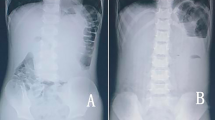Abstract
Objective
Bezoars are foreign bodies developed due to the swallowing of indigestible substances in the stomach that accumulate in the lumen of the gastrointestinal tract. This study aimed to compare the location, size, and diameter of bezoars between patients with and without a history of previous gastrointestinal surgery and between operated and non-operated patients retrospectively.
Methods
A total of 188 patients who presented to our gastroenterology clinic and in whom bezoar was suspected on clinical examination and the diagnosis confirmed through abdominal CT scans were included in the study. The patients were divided into two groups; patients with a history of previous gastrointestinal surgery were assigned to Group 1 (n = 70), and those who had no history of previous surgery (n = 118) to Group 2.
Results
The mean age was found as 56.16 ± 15.75 years in Group 1 and 57.71 ± 15.95 years in Group 2. The mean bezoar width was significantly higher in Group 1 (p = 0.049). The mean bezoar length was significantly higher in Group 1 (p = 0.004). Considering localization of bezoars, the rate of patients who underwent enterotomy (80%) was statistically significantly higher than the patients who underwent gastrotomy (23.50%), gastrotomy + milking (28.60%) and milking (44.70%) in the operations performed in the jejunum.
Conclusion
Bezoars are a rare cause of intestinal obstruction. The median width and length of the bezoars were significantly higher in patients with a history of previous gastric surgery. There was no significant difference in other parameters. The most common localization was jejunum.

Similar content being viewed by others
Data availability
Data used in this study can be provided on reasonable request.
References
Vorovskiy OO, Shushkovska YY, Afanasiuk OI. Stomach bezoaris, causes of development, diagnosis and methods of treatment. Wiad Lek. 2021;74(1):128–31.
Dikicier E, Altintoprak F, Ozkan OV, Yagmurkaya O, Uzunoglu MY. Intestinal obstruction due to phytobezoars: an update. World J Clin Cases. 2015;3(8):721–6.
Gizha LY, Tsyupka BV, Gizha BI. Bezoar zheludka i kishechnika u devochki s oligofreniyey. [Bezoar of the stomach and intestines in a girl with oligophrenia]. Sovremennaya Pediatriya. 2016;1 (72):146–147. Available from: http://sp.med-expert.com.ua/article/view/SP.2016.73.146. (in Russian).
Espinoza RG. Gastrointestinal bezoars. Rev Med Chil. 2016;144(8):1073–7.
Kajihara Y. Gastric bezoar (phytobezoar). Postgrad Med J. 2019;95(1126):455.
Baymakhanov AN, Smagulov AM, Kozhakhmetov TK, et al. Gigantskiy trikhobezoar zheludka (kratniy obzor literatury i sobstvennoye klinicheskoye nablyudeniye) [Giant trichobesoar of the stomach (a brief review of the literature and our own clinical observation)]. Vestnik KazNMU. 2016;3(1):104–7.
Ezziti M, Haddad F, Tahiri M, et al. Gastric trichobezoar: about a case. Pan Afr Med J. 2017;26:74.
Placone N, Mann S. A Trichobezoar of gastric proportions. Clin Gastroenterol Hepatol. 2020;18(2): e18.
Altintoprak F, Gemici E, Yildiz YA, Uzunoglu MY, Kivilcim T. Intestinal obstruction due to bezoar in elderly patients: risk factors and treatment results [published correction appears in Emerg Med Int. 2019 Sep 2;2019:1568134]. Emerg Med Int. 2019;2019:3647356.
Altintoprak F, Dikicier E, Deveci U, et al. Intestinal obstruction due to bezoars: a retrospective clinical study. Eur J Trauma Emerg Surg. 2012;38(5):569–75.
Aydin I, Sengul I, Sengul D. Phytobezoar: an unusual condition leading to small bowel obstruction. Cureus. 2022;14(4): e23885.
Tang MH, Heng G. Surgical management of intestinal obstruction from phytobezoar. J Acute Care Surg. 2019;9(2):60–5.
Kement M, Ozlem N, Colak E, Kesmer S, Gezen C, Vural S. Synergistic effect of multiple predisposing risk factors on the development of bezoars. World J Gastroenterol. 2012;18:960–4.
Hoover K, Piotrowski J, St Pierre K, Katz A, Goldstein AM. Simultaneous gastric and small intestinal trichobezoars—a hairy problem. J Pediatr Surg. 2006;41:1495–7.
Lee J. Bezoars and foreign bodies of the stomach. Gastrointest Endosc Clin N Am. 1996;6:605–19.
Tolan HK, Canbak T, Acar A, Özpek A, Zambak O. Mechanical intestinal obstruction due to phytobezoar: retrospective cohort study. Laparosc Endosc Surg Sci. 2020;27(2):98–101.
Gökbulut V, Kaplan M, Kaçar S, AkdoğanKayhan M, Coşkun O, Kayaçetin E. Bezoar in upper gastrointestinal endoscopy: a single center experience. Turk J Gastroenterol. 2020;31(2):85–90.
Pujar KA, Pai AS, Hiremath VB. Phytobezoar: a rare cause of small bowel obstruction. J Clin Diagn Res. 2013;7:2298–9.
Oh SH, Namgung H, Park MH, Park DG. Bezoar-induced small bowel obstruction. J Korean Soc Coloproctol. 2012;28(2):89–93.
Ersan Y, Yavuz N, Yüceyar S, et al. Gastric bezoars requiring surgical treatment. Cerrahpaşa J Med. 2005;36:128–33.
Funding
This study did not receive financial support.
Author information
Authors and Affiliations
Contributions
Conceptualization: AM, FA. Methodology: HD, UD. Formal analysis: MD. Investigation: MY. Writing—original draft: AM, FA. Writing—review & editing: AM, İFK. Supervision: FA.
Corresponding author
Ethics declarations
Conflict of interest
The authors declare no conflict of interest to disclose.
Rights and permissions
Springer Nature or its licensor (e.g. a society or other partner) holds exclusive rights to this article under a publishing agreement with the author(s) or other rightsholder(s); author self-archiving of the accepted manuscript version of this article is solely governed by the terms of such publishing agreement and applicable law.
About this article
Cite this article
Muhtaroğlu, A., Yiğit, M., Demir, H. et al. Evaluation of the location, number and diameter of bezoars in patients with a history of previous gastrointestinal surgery. Eur J Trauma Emerg Surg 49, 1783–1789 (2023). https://doi.org/10.1007/s00068-023-02220-0
Received:
Accepted:
Published:
Issue Date:
DOI: https://doi.org/10.1007/s00068-023-02220-0




